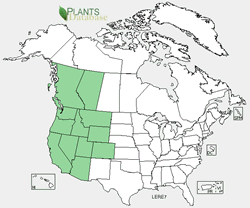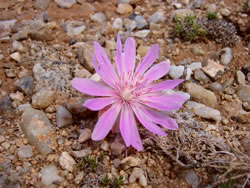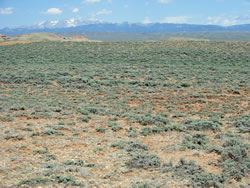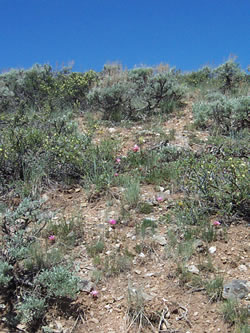Plant of the Week
 Lewisia rediviva range map. USDA PLANTS Database.
Lewisia rediviva range map. USDA PLANTS Database.
 Bitterroot flowers look quite striking against gravel. Photo by Andrew Kratz.
Bitterroot flowers look quite striking against gravel. Photo by Andrew Kratz.
 Sagebrush shrubland habitat for bitterroot in Wyoming. Photo by Andrew Kratz.
Sagebrush shrubland habitat for bitterroot in Wyoming. Photo by Andrew Kratz.
 Bitterroot flowers scattered among sagebrush. Photo by Andrew Kratz.
Bitterroot flowers scattered among sagebrush. Photo by Andrew Kratz.
Bitterroot (Lewisia rediviva)
By Andrew Kratz, USDA Forest Service
Bitterroot is widespread in the western United States, ranging from Washington and California eastward to Montana (where it is the state flower), Colorado, and Arizona. This ephemeral perennial plant grows on well-drained gravelly soils in dry shrublands, often dominated by sagebrush, but also in piñon-juniper woodlands, oak woods, and ponderosa pine or Douglas-fir forests. It can be found at elevations from 2,500 feet in California to over 10,000 feet in Utah. Early in spring, the succulent, fingerlike leaves elongate. Later, normally after the leaves have withered, deep pink to rose (or sometimes white) flowers emerge to present a striking sight: beautiful wildflowers scattered across what otherwise may appear to be bare gravel, as if they had been dropped on the ground. The flowers are up to 2 inches across.
Bitterroot is a culturally significant plant for several Native American tribes in the West (Flathead, Kutenai, Nez Perce, Paiute, Shoshoni and others). Traditionally, the roots were gathered, dried for storage, and used for food or trade. The root is bitter, so it was cooked and often mixed with meat or berries.
Meriwether Lewis first collected the species for western science in July of 1806, in what is now called the Bitterroot Valley in Montana. George Drouillard, a hunter and interpreter on the Lewis & Clark Expedition, had brought the plant to his attention the previous fall after Drouillard had a run-in with some Shoshone who left him in possession of some of their belongings. The woven bags included dried roots of three species, one of which came to be called racine amer by the French trappers, meaning “bitter root”. Lewis collected whole plants near Travelers’ Rest Creek, and gave them to Frederick Pursh after returning to Philadelphia. Pursh described a new genus and named it Lewisii in honor of Lewis. The species was named rediviva from the Latin word meaning “reviving from a dry state” referring to the ability of the plant to grow again after having been dug up, dried whole, and stored for months, which the specimen presented to Pursh in fact did, much to the amazement of those at The Academy of Natural Sciences in Philadelphia!

